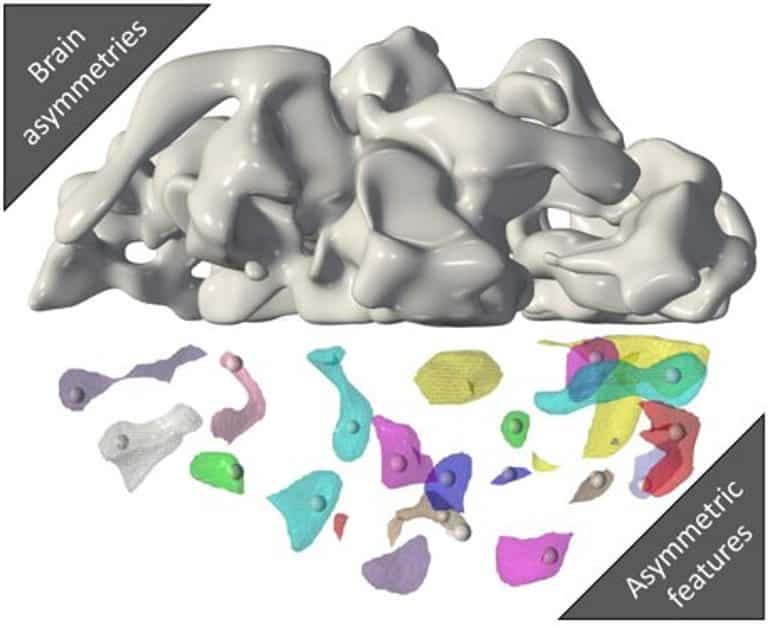Summary: Greater left-brain asymmetry can predict both better and average performance on a foundational level of reading ability.
Source: PLOS
Researchers led by Mark Eckert at the Medical University of South Carolina, United States, report that two seemingly opposing theories of language processing are both correct.
Publishing in the open-access journal PLOS Biology on April 5th, the study shows that greater left-brain asymmetry can predict both better performance and average performance on a foundational measure of reading ability, depending on whether analysis is conducted over the whole brain or in specific regions.
Being able to fluently convert written symbols into speech sounds is a basic aspect of reading that varies from person to person and is difficult for individuals with conditions like dyslexia. While structural asymmetries between the right and left sides of the brain seem to be related to this ability, exactly how remains a mystery.
Using structural MRI from over 700 children and adults, along with a reading test of pseudo-words and a mathematical method called persistent homology, the new study tested two opposing theories of how brain asymmetries should affect phonological processing.
The researchers developed a way to determine levels of brain asymmetry from the MRI images using persistent homology. They found that when the location of each individual’s most asymmetric region was considered, greater left-brain asymmetry was related to better pseudo-word reading ability. This supports a cerebral lateralization hypothesis.

At the same time, they found that greater left-asymmetry in specific regions—including a motor planning region called Brodmann Area 8, and a performance monitoring region called the dorsal cingulate—were associated with average reading ability, which supports a canalization hypothesis.
Of note was that pseudo-word reading ability was not consistently related to asymmetries in brain regions known to be important for specific language functions. How left/right structural asymmetries affect other types of reading abilities and influence the functions of a left language network remains to be studied.
Eckert adds, “Our findings indicate that, at a population level, structural brain asymmetries are related to the normal development of a speech sound processing ability that is important for establishing proficient reading.”
About this neuroscience research news
Author: Press Office
Source: PLOS
Contact: Press Office – PLOS
Image: The image is credited to Federico Iuricich
Original Research: Open access.
“Cortical asymmetries at different spatial hierarchies relate to phonological processing ability” by Eckert MA, Vaden KI Jr, Iuricich F, Dyslexia Data Consortium (2022). PLOS Biology
Abstract
Cortical asymmetries at different spatial hierarchies relate to phonological processing ability
The ability to map speech sounds to corresponding letters is critical for establishing proficient reading. People vary in this phonological processing ability, which has been hypothesized to result from variation in hemispheric asymmetries within brain regions that support language.
A cerebral lateralization hypothesis predicts that more asymmetric brain structures facilitate the development of foundational reading skills like phonological processing. That is, structural asymmetries are predicted to linearly increase with ability. In contrast, a canalization hypothesis predicts that asymmetries constrain behavioral performance within a normal range. That is, structural asymmetries are predicted to quadratically relate to phonological processing, with average phonological processing occurring in people with the most asymmetric structures.
These predictions were examined in relatively large samples of children (N = 424) and adults (N = 300), using a topological asymmetry analysis of T1-weighted brain images and a decoding measure of phonological processing. There was limited evidence of structural asymmetry and phonological decoding associations in classic language-related brain regions.
However, and in modest support of the cerebral lateralization hypothesis, small to medium effect sizes were observed where phonological decoding accuracy increased with the magnitude of the largest structural asymmetry across left hemisphere cortical regions, but not right hemisphere cortical regions, for both the adult and pediatric samples.
In support of the canalization hypothesis, small to medium effect sizes were observed where phonological decoding in the normal range was associated with increased asymmetries in specific cortical regions for both the adult and pediatric samples, which included performance monitoring and motor planning brain regions that contribute to oral and written language functions.
Thus, the relevance of each hypothesis to phonological decoding may depend on the scale of brain organization.







